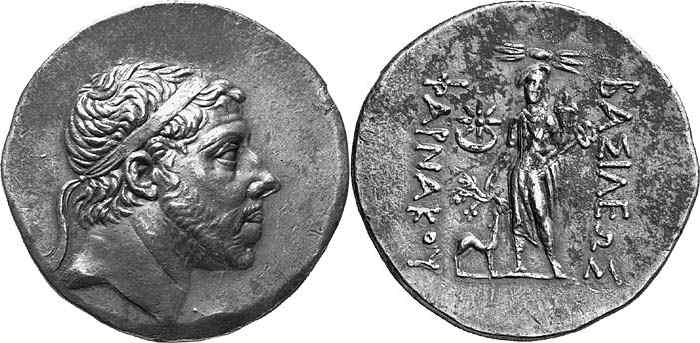Amaseia (?) (Pharnaces), silver, tetradrachms (200-169 BCE)
From SILVER
(Redirected from S 1639 - Amaseia (?) (Pharnaces), silver, tetradrachms (200-169 BCE))
200 BCE - 169 BCE Silver 4,321 kg
Description
| ObverseInscription or printing placed on the obverse.: | Diademed head to right |
| ReverseInscription or printing placed on the reverse.: | BAΣIΛEΩΣ MIΘPAΔATOY to right, ΦΙΛOΠATOPOΣ KAI ΦΙΛΑΔΕΛΦΟY to left (Greek).Perseus standing facing, holding harpa and severed head of Medusa, above, crescent above star, monogram to inner left |
Mint and issuing power
| MintIdentifies the place of manufacture or issue of a numismatic object.: | Amaseia | Ancient regionAncient region.: | Pontus | Modern countryModern country: Turkey | AuthorityIdentifies the issuing power. The authority can be "pretended" when the name or the portrait of X is on the coin but he/she was not the issuing power. It can also be "uncertain" when there is no mention of X on the coin but he/she was the issuing power according to the historical sources: | Pharnaces I of Pontus (king of Pontus, 2nde c. BC), Pontic kingdom |
Chronology
| FromIdentifies the initial date in a range assigned in a numismatic context. | 200 BCE | toIdentifies the final date in a range assigned in a numismatic context.. | 169 BCE | PeriodTime period of the numismatic object.: Hellenistic 323-30 BC |
Physical description
| MetalThe physical material (usually metal) from which an object is made.: | Silver |
Median weightMedian of the weights of numismatic objects (in grams). in grams | 17.00 | DenominationTerm indicating the value of a numismatic object. Examples: tetradrachm, chalkous, denarius.: | tetradrachm |
StandardStandard.: | Attic |
Image

S1639 Pharnakes tetradrachms.jpg [1]
References
| Die study referencePublication of the study: | Callataÿ 20091Callataÿ 2009, p. 70-73 | ||
| Coin series referenceReference to coin series study: | Sear II2Sear II, n° 7242, HGC 73HGC 7, n° 323 | ||
| Coin series web referenceCoin series web references: | |||
Obverse dies distribution
Reverse dies distribution
no distribution is available
Quantification
| Number of obversesNumber of obverse dies. ᵖ (o) | 9 | Number of singletons (o1)The number of singleton coins. ᵖ | 6 |
| Number of reverse diesNumber of reverse dies. (r) | 15 | Number of coinsNumber of coins. (n) | 22 |
| Coins per obverse dieNumber of coins per obverse die. (n/o) | 2.44 | Coins per reverse dieNumber of coins per reverse die. (n/r) | 1.47 |
| Reverse per obverse ratioRatio of obverse dies divided by reverse dies. (r/o) | 1.67 | Percentage of singletons (o1)number of coins (n) divided by the number of singletons (o1) ᵖ | 66.67 % |
| Original number of dies (O) (Carter 1983 formula)The estimation of the number of coins according to Carter 1983 ᵖ | 12.71 | Coins struck if 20,000 as average productivity per dieCoins made if the average productivity for obverses (according to Carter) is 20,000. ᵖ | 254,200 |
| Original number of dies (O) (Esty 2011 formula)The estimation of the number of coins according to the singleton formula in Esty 2011 ᵖ (O) | 15.23 | Survival rate if 20,000 as average productivity per dieSurvival rate if average productivity is 20,000. ᵖ | 0.00009 |
| Coverage (o = % of O) (Esty 1984 formula)Esty 1984 - coverage (% of O) ᵖ (o = % of O) | 72.73% | Die productivity if survival rate 1/2,000Average productivity if survival rate is 1/2,000. ᵖ | 3,461.84 |
| Weight of silver (in kg) if 20,000 coins per die (O = Carter formula)Carter 1983 * Median weight * 20000 (*10 if gold or electrum) ᵖ | 4,321 kg <br /> 4,321 kg | Die productivity if survival rate 1/5,000Average productivity if survival rate is 1/5,000. ᵖ | 8,654.6 |
Remarks
Most likely one single workstation Likely military For an error in the die-study, see: https://pro.coinarchives.com/a/lotviewer.php?LotID=2081160&AucID=4952&Lot=326